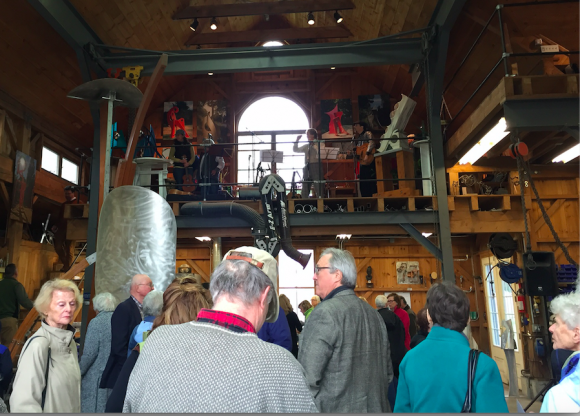
More than 80 people gathered in Gil Boro’s Studio 80 on Lyme Street in Old Lyme Sunday afternoon to hear a variety of speakers give updates on the latest developments in the saga involving the Federal Rail Authority’s (FRA) NEC Future’s proposals for an upgraded high speed railroad track from Washington DC to Boston. The event had a lighter side with musical performances from Ramblin’ Dan Stevens, Clayton Allen and friends, and the Localmotives with Eleanor Robinson, the Shrivers and friends. But the main thrust of the program was to educate and inform the attendees about the status of FRA’s plans … and what to do about them.
Greg Stroud, who has spearheaded the movement to fight Alternative 1 –- the route that travels through the center of Old Lyme – spoke first explaining that in spring 2012, when the FRA first announced a plan to invest in and modernize high speed rail in the northeast corridor, they began with 98 alternatives. He pointed out that back then, “I don’t think you’ll find a single complaint from Old Lyme, “Because not one of these alternatives included plans for running a railroad through the historical district of Old Lyme.”
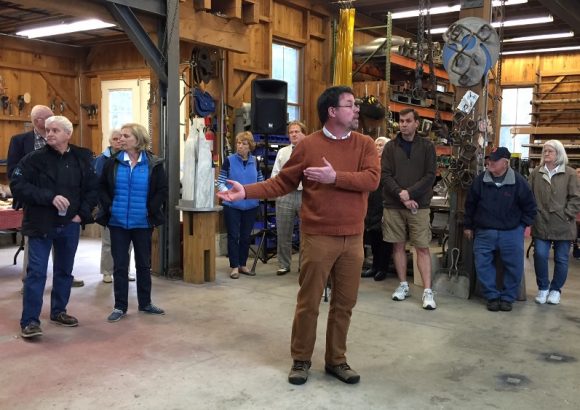
It was only in November 2015 when the FRA issued their Tier 1 Draft Environmental Impact Statement (EIS) that “Old Lyme was mentioned for the first time” in the proposals and by that time, the original 98 alternatives had been narrowed down to just three. Moreover, the route through Old Lyme – the 50-mile bypass running from Old Saybrook to Kenyon, R.I. known as Alternative 1 – featured an “aerial structure’ traversing Lyme Street some 40 ft. above street level. He commented calmly, “This was kind of disturbing.”
The initial comment period for the Tier 1 study closed at the end of January. It was then extended to Feb. 15 and after an extraordinary number of comments from the residents of Old Lyme (1,200 out of a total of 3,000 according to Old Lyme First Selectwoman Bonnie Reemsnyder), the FRA introduced the idea of a tunnel going from Old Saybrook and Stroud said, “coming out around Whippoorwill [Rd.]”
Stroud pointed out that although “a tunnel sounds better … we’re a community of marshes .. this Historic District is built on soil and groundwater,” and suggested the audience should Google the word “dewatering.” He said that in order to build a tunnel, “You have to pump the water out of the soil,” noting soil tends to settle, “when you pump out groundwater,” adding, “There really isn’t a nice way to build a tunnel,” and then the comment, “It’s troubling.”
Stressing that he could not say definitively this would happen, Stroud noted that the FRA is unable to do so either. He mentioned that the FRA is “pretty friendly” and in numerous conversations with involved parties in Old Lyme, the FRA has said consistently that it, “will do the studies afterwards.”
Stroud’s point, however, is that the FRA is currently determining its preferred route for the track based on the feedback it has received to date. It will announce that route in September and then undertake the necessary studies. But, Stroud emphasized, “Once that route is drawn on the map, and if that route runs under, over, or through Old Lyme, it’s going to be enormously difficult and expensive, to erase.”
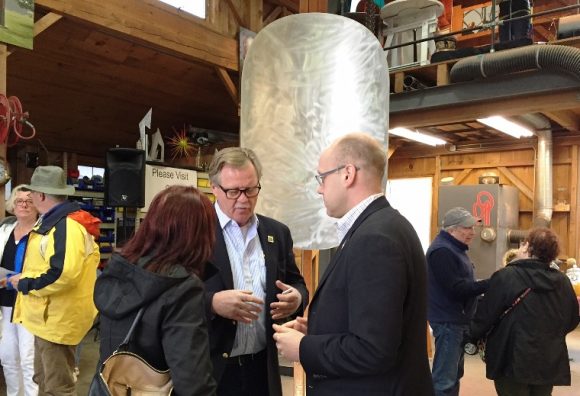
Stroud continued that it was important to know where town government and state officials stood on the proposal, noting, “I know where our First Selectwoman [Bonnie Reemsnyder] stands on this,” and adding that from the start, State Representative Devin Carney (R), “took me seriously” and State Senator Paul Formica (R), “was very supportive,” drawing laughter when he confessed, “ And I’m a Democrat!”
But Stroud noted despite the fact, “We’ve back-channeled and we’ve front-channeled … it’s been pretty quiet,” and there has been “Little from [Congressman Joe] Courtney,” and with regard to Senator Richard Blumenthal, Stroud stated emphatically, “We don’t know if he’s with us or against us.” He urged the audience to “get our public representatives to take a stand,” by calling and/or writing to Senator Blumenthal’s office asking him to take a stand in order to, “Get this off the table.”
Pre-addressed postcards were available at the event for attendees to write a personal note to Senator Blumenthal, who Stroud noted is “the most active supporter of high-speed rail in Congress” and the ranking member of the Senate committee in charge of the rail planning process. Stroud said Blumenthal could therefore be enormously influential in the final route decision.

BJ Bernblum then read a statement on behalf of Old Lyme First Selectwoman Bonnie Reemsnyder, who was unable to attend the event. It opened with Reemsnyder thanking all the people who had written to the FRA during the Tier 1 comment period, noting that at a subsequent meeting with the NEC Futures team, “ I believe that our concerns were taken seriously,” adding, “Of those concerns, we were effective in the most important one, and that is the removal of the plan for an aerial structure going through the heart of Old Lyme.”
Reemsnyder noted in her statement, however, “While this is good news, I acknowledge that the idea of a tunnel across the Connecticut River comes with its own set of concerns, which we also addressed in our meeting. The Connecticut River and its estuary are of such vital importance that we must assure that valid research and extreme caution are used in planning this type of work.” She stressed that a team of people from the regional government council (RiverCOG) and some Old Lyme residents “are gathering important data on the Connecticut River to be used if and when the time comes to thoroughly discuss the impact of a tunnel.”
In conclusion, Reemsnyder’s statement said, “We are continuing to keep the communication open with the FRA, our state officials, our Connecticut Delegation and state representatives to advocate for our community and protect our future,” adding, “You can see our summary of our meeting in a letter to the FRA on the town website, along with their response to that summary.”
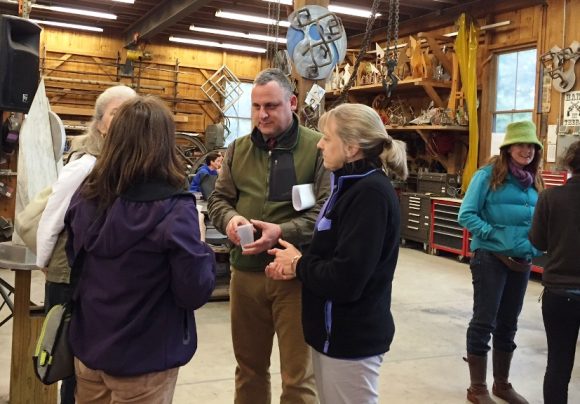
The third speaker was Daniel Mackay, Executive Director of the Connecticut Trust for Historic Preservation. He commented that from both his perspective in his current position and his prior experience as a municipal government member in the Town of New Scotland, N.Y. that Old Lyme’s town government “was doing the right things,” but stressed, “They need you [the audience],” explaining, “Their effectiveness is bolstered by a grassroots movement.”
He described the positive relationship between the Old Lyme town government and the local environmental, cultural and historical organizations as, “a potent mix” that he felt could be effective in conveying the message that “there are other ways to deliver high speed rail … without the wreckage of going through Old Lyme.”
In similar vein to Stroud, he reflected that, “While the process has been silent (while the FRA considers which option to select as its preferred route), I want to encourage you not to be silent,” adding, “You need to keep pressing home the point that this is not the place for high speed rail.”
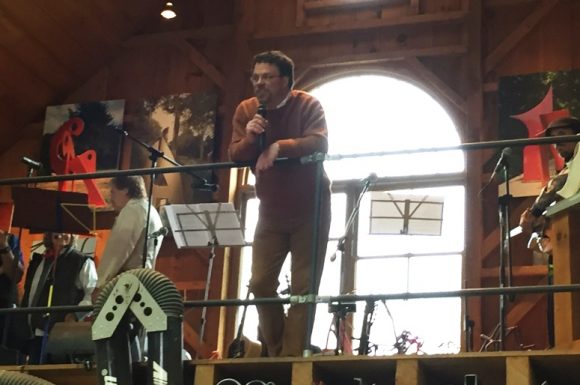
He explained that the Trust has “taken on fiscal responsibility” for the project known as ‘SECoast,’ which is described on its Facebook page as, “An independent nonprofit, partnered with the Connecticut Trust and currently focused on the topic of high-speed rail in Southeastern Connecticut,” with a mission of, “Organizing and educating the public to protect Southeastern Connecticut and the Lower Connecticut River Valley.”
Mackay said the Trust will be “picking up costs” associated with the project and donations to the group can now be accepted. He said information on how to donate to support the project is on the SECoast website and 100 percent of any donation will go to the project and is tax-deductible.
Mackay then cited what he described as a “visionary” Statement of Significance written in 1971 by Margaret Crosby Brown of Old Lyme when the town was applying to establish an historic district. Crosby Brown mentioned, “The town’s long awareness of the necessity for strong stewardship for both the historical and environmental aspects of Old Lyme,” noting at that time, “This is especially so when the destructive forces of accelerated change are all too apparent.”
Concurring with Crosby Brown’s opinion about the “necessity for strong stewardship,” he concluded with the words, “You have something very special here,” adding emphatically, “Let’s press that point.”